Driving Lines
Author: Jeff Davis
Driving a car takes several skill sets that have to operate in co-ordination in order to navigate a complex track, avoid accidents and win races. These include sight, feel, awareness and knowledge, all of which must be brought together by your brain. Therefore thinking ahead is an absolute essential ingredient for successful driving. This document is aimed at preparing you to think in advance and use the skills outlined to maximum effect thus giving you the best chance of winning a race.
Driving a car is not a simple act of jumping in, pressing the go button and steering round corners. There are 5 main factors which you must take into consideration before setting off on a journey, whether this is a race or just a trip down to the shops. These factors include:
- Road condition – Dry, Wet, Bumpy, Surface, Dusty, Dirty etc.
- Road layout – Straight, Twisty, Sharp Bends, Width etc.
- Capability of the car – Turning Circle, Braking, Acceleration, Power, Centre of Gravity, Balance, Tyres etc.
- Traffic conditions – No traffic, Medium traffic, Crowed Road, Speed etc.
- Your capability – Experience
Any combination of these will affect the way you have to approach driving a vehicle, no matter if this is an electric car or a Formula 1 racer. Couple these with the skill sets you have to co-ordinate results in considerable concentration every time you sit in a car.
The above combinations also affect the driving lines you can take when racing.
One other thing to remember is that a car will go faster in a straight line. Turn into a corner and energy is transferred to the tyres, which is subsequently used to change direction of the vehicle and therefore lost. This will automatically slow the car down requiring more energy to be taken from the batteries to get the car back up to speed. This uses up the stored energy reducing the life of the batteries and hence the distance you can travel on a single charge. Sounds obvious but consider a 4 hour race, changing direction such as weaving down a straight or having to over compensate for incorrect cornering etc will have a devastating effect on the overall distance you will cover. The way this is optimised is by using the correct driving lines both on the straights and the corners, maximising the speed at all times and lowering the drain of power from the batteries. The other thing to remember is that the shortest way round a track is not necessarily the fastest.
What is a driving line?
A Driving Line (also know as a Racing Line) is the imaginary line a car would paint on the road when it goes around a corner or down a straight. It is not the shortest distance around a corner but one that minimises the time spent in a corner whilst maximising the speed through the corner. It is achieved by fitting in the maximum smooth arc possible into the corner, starting at the entry point and finishing at the exit point.
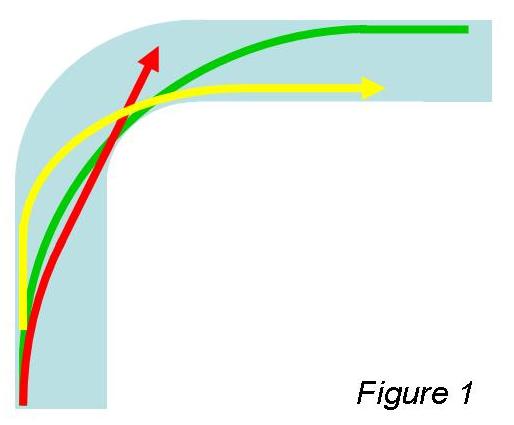 Figure 1 shows that there is an ideal point of turning into the corner [GREEN] and an ideal speed for each corner encountered. Turning too early is completely the incorrect way to approach any corner, do this and you will be off the road [RED] unless you slow down considerably. Turning too late [YELLOW] and you have to over steer and again loose precious speed. However, this is from a Greenpower racing point of view, if you had a powerful combustion engine car, the yellow line may well be the one for you.
Figure 1 shows that there is an ideal point of turning into the corner [GREEN] and an ideal speed for each corner encountered. Turning too early is completely the incorrect way to approach any corner, do this and you will be off the road [RED] unless you slow down considerably. Turning too late [YELLOW] and you have to over steer and again loose precious speed. However, this is from a Greenpower racing point of view, if you had a powerful combustion engine car, the yellow line may well be the one for you.
Let’s look at each of these. First the red line, indicating the car has turned too early into the corner. This is normally what happens to first time drivers, they see the corner approaching quickly and over-react by turning early. The result is that they arrive incorrectly at an early apex of the corner. With more of the corner to come the result is either running out of road as they try to exit the corner at speed or having to turn more violently to keep on the road but transfer copious amount of energy into the tyres (and potentially brakes) slowing down the car significantly to avoid an accident. The car would then be slow out of the corner requiring much more energy from the battery to get back up to speed.
Next under scrutiny is the yellow line, indicating that the car has turned into the corner far too late. This happens when the driver turns up at the corner far too fast and misses the turning point. Unlike the red line where the violent turn is applied after the apex this scenario requires a violent turn before the apex. The end result is the same however with the slight difference that you will either make a late apex or miss the apex altogether (depending on your speed – again this is from a GreenPower point of view where the fastest cars reach around 50mph on the straights). The car will still slow down as before though.
So that brings us to the green line, the Louis Hamilton approach to driving. Here the driver will arrive at the corner at the correct speed. This being achieve by: lifting off the power, using the brakes (whilst in a straight line) to slow to the required speed, selecting the correct gear for the exit of the corner and SMOOTHLY turning the car into the corner to meet the correct apex. At the apex the driver can apply the power once again to keep momentum going and hence only loose minimal energy and smoothly straighten up the car by the exit point of the corner. Simple! For reference you can visit the Wikipedia entry at http://en.wikipedia.org/wiki/Apex_(racing).
Not all corners are equal.
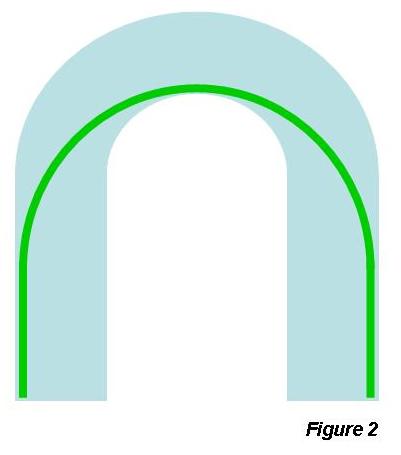 Life would be simple if all corners were 90 degrees and had a straight road before and after however, life is not fair as we all know. You often come across the notorious hairpin bend, a definite attempt by the track designers to slow you down and make life difficult. However the same principles apply when approaching this kind of bend. Figure 2 gives the correct example of the required driving line. Turning in too early or too late will have a dramatic effect, both will see you off the track or having to slow to such an extent that you loose all forward momentum.
Life would be simple if all corners were 90 degrees and had a straight road before and after however, life is not fair as we all know. You often come across the notorious hairpin bend, a definite attempt by the track designers to slow you down and make life difficult. However the same principles apply when approaching this kind of bend. Figure 2 gives the correct example of the required driving line. Turning in too early or too late will have a dramatic effect, both will see you off the track or having to slow to such an extent that you loose all forward momentum.
A hair-pin bend is going to be a slower corner than a 90 degree one as there is simply more corner to negotiate, in this case twice as much. It is therefore obvious that the apex is much deeper into the corner than that of the first we examined. You can still draw the smooth arc to find the perfect driving line. It will be might tighter and slower but will still minimise your time in the corner and maximise the speed of the car.
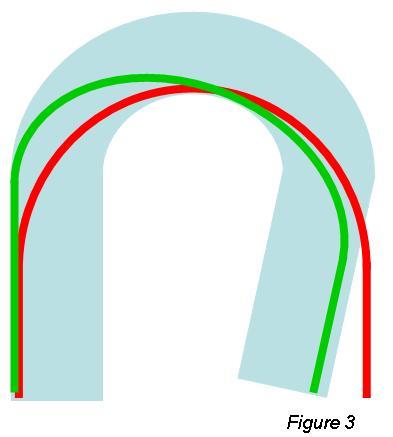 But again not all hairpins are equal. The classic for our team is the one encountered at the Darley Moor race track. Figure 3 shows a similar hairpin bend which is extended beyond the 180 degree mark. In this case you need to slightly change the driving line around the corner. The red line which was used in the first example is no longer the one to take as it will now run out of road. Instead we now look for the late apex by turning in later. If you draw a line between the entry point and the exit point you will still see that the arc is the same smooth line and slightly shallower which means a little slower into the corner. Not a lot slower but still slower. The smooth entry into the corner is all the more essential here as the tightness of the bend means much more load on the tyres and as such will distort them more giving the possibility of punctures simply by overworking the tyre to the point of failure. We have seen this many times at Darley Moor where the car has to limp down the back straight to the pits on three wheels, losing considerable time.
But again not all hairpins are equal. The classic for our team is the one encountered at the Darley Moor race track. Figure 3 shows a similar hairpin bend which is extended beyond the 180 degree mark. In this case you need to slightly change the driving line around the corner. The red line which was used in the first example is no longer the one to take as it will now run out of road. Instead we now look for the late apex by turning in later. If you draw a line between the entry point and the exit point you will still see that the arc is the same smooth line and slightly shallower which means a little slower into the corner. Not a lot slower but still slower. The smooth entry into the corner is all the more essential here as the tightness of the bend means much more load on the tyres and as such will distort them more giving the possibility of punctures simply by overworking the tyre to the point of failure. We have seen this many times at Darley Moor where the car has to limp down the back straight to the pits on three wheels, losing considerable time.
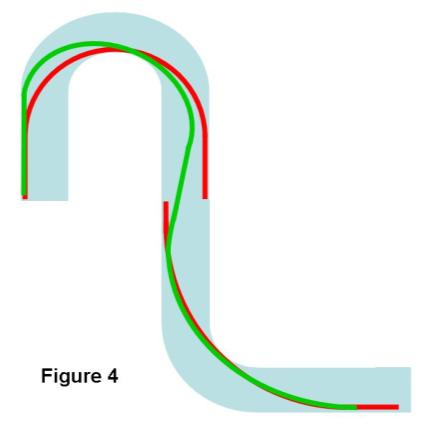 Now, to make it more difficult, corners are not a stand-alone feature of the race track. They are not always followed by a long straight; it is quite likely that one corner will be followed by another corner giving you a series of turns to negotiate. Let’s take the case shown in Figure 4. Here we have a hairpin bend followed directly by a left hand 90 degree bend. If taken in isolation the red line would show the correct driving line around each corner. However, if we take the red line around the hair pin we find ourselves on the wrong side of the track for the entry point into the next corner. We therefore have to “think ahead” when driving a race. The corner “after” the one we are approaching requires us to be on the other side of the track than the normal driving line would take us, therefore we have to adjust the initial driving line to give us the best entry point for the second corner so as to maximise our speed. We can apply the driving line used in Figure 3 to position the car as close to the normal entry point for the next corner and still maintain the smooth (or very close to it) arc required to negotiate the right hand bend. Of course, you may need to adjust even this line depending on what is coming up next on the track – THINK AHEAD!
Now, to make it more difficult, corners are not a stand-alone feature of the race track. They are not always followed by a long straight; it is quite likely that one corner will be followed by another corner giving you a series of turns to negotiate. Let’s take the case shown in Figure 4. Here we have a hairpin bend followed directly by a left hand 90 degree bend. If taken in isolation the red line would show the correct driving line around each corner. However, if we take the red line around the hair pin we find ourselves on the wrong side of the track for the entry point into the next corner. We therefore have to “think ahead” when driving a race. The corner “after” the one we are approaching requires us to be on the other side of the track than the normal driving line would take us, therefore we have to adjust the initial driving line to give us the best entry point for the second corner so as to maximise our speed. We can apply the driving line used in Figure 3 to position the car as close to the normal entry point for the next corner and still maintain the smooth (or very close to it) arc required to negotiate the right hand bend. Of course, you may need to adjust even this line depending on what is coming up next on the track – THINK AHEAD!
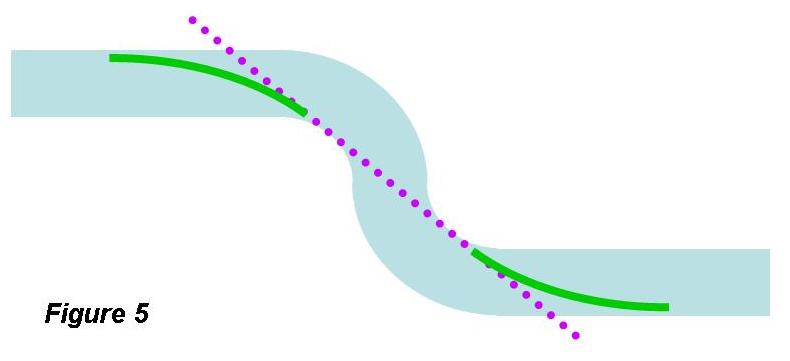 Another series of bends you can come across is the “S” bend. In memory of the late great Ayrton Senna many tracks now feature a “Senna S Bend”; a left hand curve followed by a right hand curve (of varying degrees) or vice-versa. These are often quite fast curves but can also be known as “chicanes”. The fastest line through this series of curves will only allow room for 1 car.
Another series of bends you can come across is the “S” bend. In memory of the late great Ayrton Senna many tracks now feature a “Senna S Bend”; a left hand curve followed by a right hand curve (of varying degrees) or vice-versa. These are often quite fast curves but can also be known as “chicanes”. The fastest line through this series of curves will only allow room for 1 car.
To find the driving line does depend on the aspect of the corner. In Figure 5 we have a typical chicane of 2 very close 90 degree curves. You should clip both apexes to form the correct driving line. To help you, imagine a straight line between to two apex points, and then choose an entry point for the first part of the curve and the eventual exit point. A smooth curve to the first apex and a smooth curve from the second apex to the exit point will give the correct driving line for the series of bends. Remember though, the exit point of the last phase of the bend will determine where you are positioned on the track for the next bend, so again, THINK AHEAD!
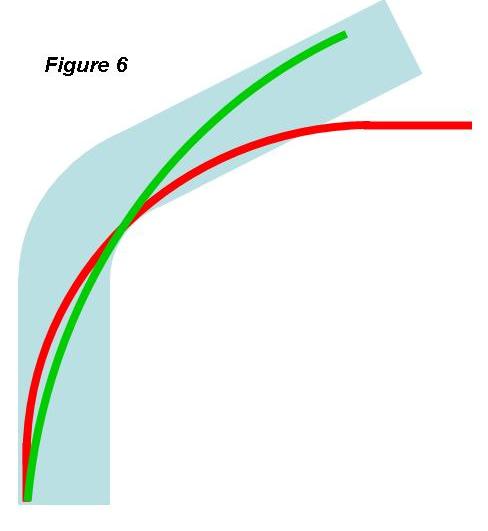 The high speed bend (less than 90 degrees) does not always require such a strict driving line; however, you should still apply the same principles as the next section of track could well demand an exact driving line. Figure 6 shows such a bend.
The high speed bend (less than 90 degrees) does not always require such a strict driving line; however, you should still apply the same principles as the next section of track could well demand an exact driving line. Figure 6 shows such a bend.
If you applied the same line (red) as you would have done for a right angled bend you see that it does not end in the correct place and will require a series of adjustments to correct. Here you can take a more protracted line, almost straight, in fact, as straight as possible. The emphasis is on the smooth entry maintaining speed and energy.
Depending on the next corner or straight you will need to adjust the line accordingly. You would need to consider if there is an immediate corner or a long or short straight after the fast bend. Speed could also be a factor in this kind of bend as it might be fun going flat out around the corner, only to find that you are standing on the brakes to make the next corner without crashing – not so much fun!
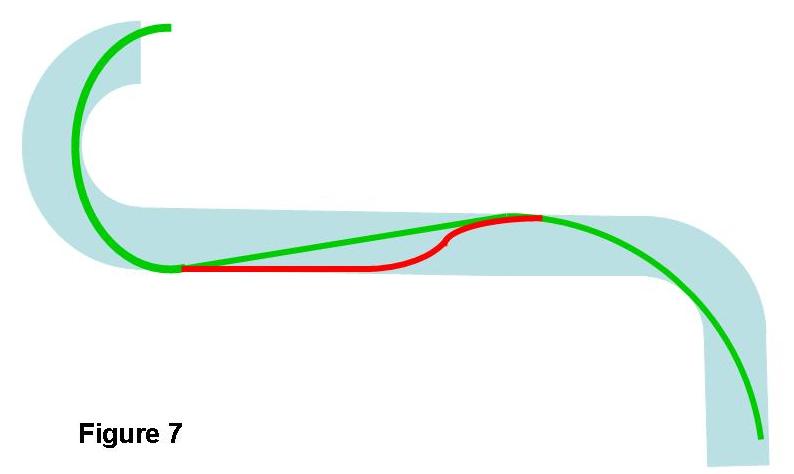 The fastest line between two points is a straight line. What an obvious statement but one which is not always observed. When entering a long straight you know that at the end is some sort of bend and due to the fact that you are going down a straight (hopefully in a straight line) means that you will arrive at that bend going very quickly. It is therefore extremely important to be in the correct position so as to enter the corner on the right driving line. You know that you want to be heading into the breaking zone in a straight line so that you are ready to turn smoothly into the corner. To get to that point as quickly as possible you imagine a straight line from the exit point of the previous corner to the breaking zone of the next and drive straight down that line. Figure 7 shows both the correct line (green) and the wrong line (red), the latter requiring some form of serious correction to get to the entry point of the corner (leading to swerving, lowering of speed, loss of energy – in fact about all the wrong things you want to happen). Smoothness, straight lines, neat curves all adds up to faster laps, further distance and winning races.
The fastest line between two points is a straight line. What an obvious statement but one which is not always observed. When entering a long straight you know that at the end is some sort of bend and due to the fact that you are going down a straight (hopefully in a straight line) means that you will arrive at that bend going very quickly. It is therefore extremely important to be in the correct position so as to enter the corner on the right driving line. You know that you want to be heading into the breaking zone in a straight line so that you are ready to turn smoothly into the corner. To get to that point as quickly as possible you imagine a straight line from the exit point of the previous corner to the breaking zone of the next and drive straight down that line. Figure 7 shows both the correct line (green) and the wrong line (red), the latter requiring some form of serious correction to get to the entry point of the corner (leading to swerving, lowering of speed, loss of energy – in fact about all the wrong things you want to happen). Smoothness, straight lines, neat curves all adds up to faster laps, further distance and winning races.
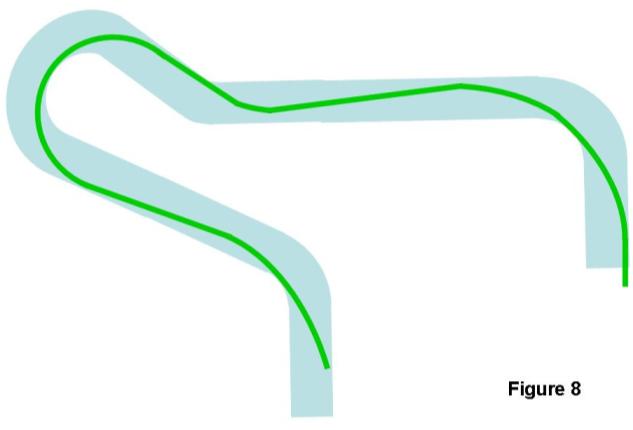 Let’s put some of this together into a series of bends which is not too dissimilar to a track we use. Applying the knowledge given above, slightly modify it to fit the track and we should get something approaching Figure 8. Here we have the approach to a hair-pin bend which required an adjusted exit point from the previous corner to arrive at the correct entry point. A late apex in the hairpin as it was greater than 180 degrees. Following this a slight left hand bend is encountered which naturally takes you across to the right hand side of the track. In front is a long straight which we can drive diagonally across to reach the breaking point for the next right hand 90 degree bend and then off for the rest of the lap.
Let’s put some of this together into a series of bends which is not too dissimilar to a track we use. Applying the knowledge given above, slightly modify it to fit the track and we should get something approaching Figure 8. Here we have the approach to a hair-pin bend which required an adjusted exit point from the previous corner to arrive at the correct entry point. A late apex in the hairpin as it was greater than 180 degrees. Following this a slight left hand bend is encountered which naturally takes you across to the right hand side of the track. In front is a long straight which we can drive diagonally across to reach the breaking point for the next right hand 90 degree bend and then off for the rest of the lap.
Speed is not everything.
To be fast around a circuit does not mean you have to be flat out at all stages. If you watch any racing on the television, especially Formula 1, you will notice the many different driving styles that people have. The ones who throw the car around the track quite often do not win the race. It looks exciting but unless they have exceptional power and fantastic tyres sooner or later they will fail. The smooth driver, such as Jenson Button, is one who maximises the potential of their car by going up to, but never beyond, the limits outlined in the first paragraph of this paper. Smooth entry into a corner maintains speed and energy, it also minimises the stress placed on the car and tyres. Maintaining speed gets you to the next turning point quicker, maintaining energy allows you to go a greater distance. Over a 4 hour race, every ounce of energy needs to be used to go forward – not sideways. Where you do need to deviate from the straight then the correct speed is essential.
As we do not have a variable speed control on the cars (only a simple on/off switch) balancing the power around a corner is not much of an option. It is therefore important that the correct speed is attained at the entry point to the corner. This may require a period of braking (in a straight line) just before the entry point followed by a smooth turn into the corner. When you see the apex you can apply the power to pull you around the corner and smoothly to the exit point.
Any sudden turns will not only loose energy and speed but could also cause an accident. If the driver behind you does not expect a sudden change in direction they could begin an overtaking manoeuvre which may result in you both being at the same point on the track at the same time (the scene of the accident).
As we have fast cars you will find yourself in many overtaking positions. If someone moves suddenly and unexpectedly in front of you the outcome could be the same. To avoid this “thinking ahead” is again required. In this case “anticipation” on your behalf is the answer. Giving another driver space is good practice as is sounding the horn well in advance of overtaking. However, when overtaking “do not forget” you still need to make your driving lines. It is no good hammering down the straight and overtaking on the wrong side of the car in front only to find that you have arrived at the next corner either too fast or on the wrong part of the track and having to hit the brakes even harder to make the next corner.
THINK AHEAD; when coming up to overtake another car think:
- Where do you need to be after overtaking?
- Left or right side of the track?
- Fast or slow?
- Can I complete the overtaking manoeuvre before the entry point to the next corner?
In most cases, due to the speed we race at and the width of the track a certain amount of margin exists but when approaching certain corners such as a hairpin this margin narrows considerably, so think ahead and be safe on the track.
What to do when going racing?
First thing, you need a track diagram, one big enough to show all the corners and straights with a scale to give you an idea of distances. From the track layout get a rough idea of your initial driving lines, where you think they are and where likely entry and exit points will be. At the track, either walk the circuit or get some practice laps in to test out your theory. Look at the track surface to see where the bumps are; maybe you can avoid them with a slightly different line. Maybe there are gradients which will affect your race. All in all, plan your race in advance – THINK AHEAD, do not just simply turn up and sit in the car.
